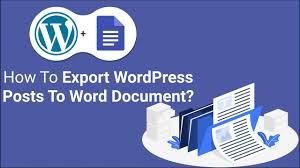Exporting WordPress posts or pages, such as blog content or WooCommerce product descriptions like “Flying Ninja” (from your “Creating Products” guide) on your site “My Shop” (from your “Blog Page” guide), to Microsoft Word documents (.doc or .docx) is useful for offline editing, sharing, or archiving. The Aspose.Words Exporter plugin, featured in the 6fc Live Educate WordPress video hosted by Aisha, is a powerful tool that simplifies this process without requiring signups. This guide details how to install, configure, and export posts and pages to Word documents, based on the video and enriched with web sources.
Note: The video primarily focuses on exporting to Word documents but mentions importing capabilities, which are covered by a separate Aspose plugin (not detailed here).
Why Use Aspose.Words Exporter?
- Seamless Export: Converts posts and pages to .docx, .doc, .odt, or .txt formats with one click (per video).
- WooCommerce Fit: Exports product pages or blog posts for documentation, complementing tools like Yoast SEO (from your “Yoast SEO” guide).
- Free & Unlimited: Uses Aspose Cloud API with no signup or limits (per video).
- Customizable Output: Includes post date, categories, excerpts, content, shortcodes, or comments (per video).
- Limitations: Limited styling in exported documents; no batch export to separate files in free version; importing requires a different plugin.
Step 1: Install and Activate Aspose.Words Exporter
- Install Plugin:
- In your WordPress dashboard, go to Plugins > Add New.
- Search for Aspose Words Exporter (per video, “Export WordPress Posts Pages to DOC/DOCX Word Document” by Aspose).
- Click Install Now, then Activate (per video).
- Alternative: Download from wordpress.org/plugins/aspose-posts-exporter/ and upload via Plugins > Add New > Upload Plugin.
- Verify Installation:
- Confirm: Aspose.Words Exporter settings appear under Settings > Aspose.Words Exporter (per video).
- Check Posts > All Posts or Pages > All Pages: An “Export to Docs” bulk action should be available (per video).
Step 2: Configure Export Settings
- Access Settings:
- Go to Settings > Aspose.Words Exporter (per video).
- Click Enable Free and Unlimited Access (per video, one-step activation for Aspose Cloud API, no signup required).
- Customize Export Options:
- Select data to include in the exported document (per video):
- Post Date: Include publication date.
- Categories: Add category names.
- Excerpts: Include post/page excerpts.
- Content: Include main content (mandatory, per video).
- Shortcodes: Process shortcodes (e.g., render as images).
- Comments: Include post comments (optional).
- Recommendation: Enable Content and Post Date for basic exports; add others as needed.
- Choose File Format:
- Options: .docx (default), .doc, .odt, .txt (per video).
- Use .docx for Microsoft Word compatibility.
- Select data to include in the exported document (per video):
- Save Changes:
- Click Save Changes (per video).
Step 3: Export Posts to Word Document
- Select Posts:
- Go to Posts > All Posts.
- Check the boxes for the posts you want to export (per video, e.g., a blog post).
- Export Single or Multiple Posts:
- Single Post:
- Select one post, choose Export to Docs from the Bulk Actions dropdown, and click Apply (per video).
- The post downloads as a single .docx file (per video).
- Multiple Posts:
- Select multiple posts (e.g., two posts, per video).
- Choose Export to Docs and click Apply.
- Posts are merged into one .docx file (per video, no separate files in free version).
- Single Post:
- Verify Download:
- Check your browser’s download folder for the .docx file (per video).
- Open in Microsoft Word to confirm content (e.g., post title, content, date).
Step 4: Export Pages to Word Document
- Select Pages:
- Go to Pages > All Pages.
- Check the boxes for the pages you want to export (per video, e.g., blog page, cart page).
- Export Pages:
- Choose Export to Docs from the Bulk Actions dropdown and click Apply (per video).
- Pages download as a single .docx file, with sections preserved (per video, e.g., multiple sections in a page).
- Verify Download:
- Open the downloaded .docx file to confirm page content (e.g., blog page layout, cart page details).
Step 5: Verify and Test
- Verify Exported Files:
- Open downloaded .docx files in Microsoft Word.
- Confirm included data (e.g., content, date, categories) matches settings (per video).
- Check shortcodes (e.g., rendered images or text) and formatting.
- Test Export Process:
- Export a single post and verify it downloads correctly.
- Export multiple posts/pages to confirm merging (per video).
- Test different formats (e.g., .doc, .odt) if needed.
- Troubleshoot:
- Export Fails?:
- Ensure Enable Free and Unlimited Access is activated (per video).
- Check internet connection for Aspose Cloud API.
- Clear cache (from your “Backup and Migration” guide).
- Missing Content?:
- Verify selected options (e.g., Content, Shortcodes) in settings.
- Re-save settings and retry.
- Formatting Issues?: Exported files have basic styling; edit in Word for advanced formatting.
- Theme Conflicts?: Test with Neve or Storefront (from your “Neve” or “Creating Products” guides).
- Contact support at aspose.cloud/support/ or check aspose.cloud/docs/.
- Export Fails?:
Step 6: Enhance with Optional Features
- Aspose.Words Exporter Features:
- Free:
- Export posts/pages to .docx, .doc, .odt, .txt.
- Include post date, categories, excerpts, content, shortcodes, comments.
- No signup or limits via Aspose Cloud API (per video).
- Premium (Aspose Cloud Plans):
- Advanced formatting options.
- Separate file exports for multiple posts.
- API access for automation.
- Pricing: Starts at $9.99/month (aspose.cloud/pricing/).
- Note: The video focuses on the free version.
- Free:
- WooCommerce Integration:
- Export product pages (e.g., “Flying Ninja”) for documentation or marketing.
- Pair with NotificationX for export-related alerts (from your “NotificationX” guide).
- Secure payments for exported product data with Razorpay or UPI QR Code (from your “Razorpay” or “UPI Payment” guides).
- Enhance search for exportable content with Search & Filter or FiboSearch (from your “Search & Filter” or “FiboSearch” guides).
- Importing Documents:
- Use Aspose.Words Importer (separate plugin, mentioned in video) to import .docx files as posts/pages.
- Install from wordpress.org/plugins/aspose-doc-importer/.
- Useful for bulk content updates or migrations.
- Custom Styling:
- Exported files use basic formatting; enhance in Word or pre-style content in WordPress.
Add CSS in WordPress for consistent post styling before export (e.g., in Appearance > Customize > Additional CSS):
.post-content { font-family: Arial; font-size: 14px; }
.post-title { color: #0073aa; }
- @media print { .post-content { margin: 20px; } }
- Align with Neve’s design (from your “Neve” guide).
Step 7: Best Practices
- Export Selection:
- Export single posts for quick edits; use bulk export for archiving (per video).
- Include only necessary data (e.g., Content, Post Date) to keep files clean.
- File Management:
- Organize downloaded files in a dedicated folder (e.g., “My Shop Exports”).
- Rename files for clarity (e.g., “Blog_Post_2025.docx”).
- Testing:
- Test exports with different post types (e.g., blog, product page).
- Verify shortcode rendering (e.g., galleries or forms).
- Check multi-section pages for proper formatting.
- Performance:
- Aspose.Words Exporter is lightweight; cache site to speed up dashboard (from your “Backup and Migration” guide).
- Monitor export times for large posts with images.
Pro Tips
- Engagement: Promote exported content with a Welcome Bar (from your “Sticky Menu” guide) or Join.chat for support (from your “Join.chat” guide).
- Security: Protect exported data with Wordfence (from your “Malware Removal” guide).
- Compliance: Use GDPR Cookie Consent for tracking cookies if analytics are included (from your “Cookie Notice” guide).
- SEO: Optimize posts before export with Yoast SEO (from your “Yoast SEO” guide).
- Backup: Save site before bulk exports with UpdraftPlus (from your “Backup and Migration” guide).
- Styling: Match pre-export styling with Neve’s design (from your “Neve” guide).
Congratulations!
You’ve successfully exported WordPress posts and pages to Word documents with Aspose.Words Exporter and 6fc Live! Your content is now ready for offline editing or sharing. For advanced formatting or separate file exports, explore Aspose Cloud plans (aspose.cloud). Combine with your other guides (e.g., “Yoast SEO,” “NotificationX,” “Neve”) for a robust platform. Need help with exporting, importing, or troubleshooting? Comment below or visit aspose.cloud/support/!

